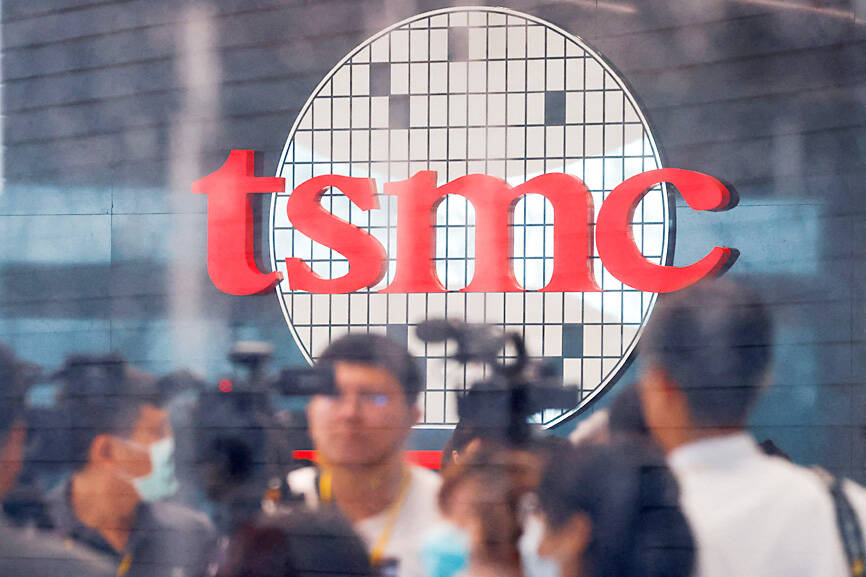The US Department of Commerce said its granting last week of up to US$6.6 billion in subsidies to Taiwan Semiconductor Manufacturing Co (TSMC, 台積電) came after the Taiwanese company pledged to produce chips made using its advanced A16 process.
TSMC Arizona Corp, a subsidiary of the Taiwanese chip giant that handles operations in the state, secured the US government subsidies under the CHIPS Incentives Program’s Funding Opportunity for Commercial Fabrication Facilities after agreeing to bring the state-of-the-art chipmaking technology to the US.
“The advanced chips that TSMC manufactures for its customers — including its A16 technology, which is the most advanced semiconductor technology in the world — are the backbone of central processing units for servers in large-scale datacenters and of specialized graphics processing units used for machine learning,” the department said in a statment.

Photo: Ann Wang, Reuters
TSMC chairman C.C. Wei (魏哲家) was quoted in the statement as saying that the final agreement signed with the department was expected to help the company “accelerate the development of the most advanced semiconductor manufacturing technology available in the US.”
In addition to direct funding of up to US$6.6 billion, the CHIPS Program Office would provide up to US$5 billion of proposed loans — which is part of the US$75 billion of loans authorized by the CHIPS and Science Act — to TSMC Arizona under the award, the department said.
TSMC is building two advanced fabs in Arizona. The first is scheduled to begin mass production of 4-nanometer chips early next year, while the second is slated to commence mass production of 3 and 2-nanometer chips in 2028.
On April 8, when TSMC signed a preliminary non-binding agreement for the subsidies, the company announced its plan to build a third fab in Arizona using its 3-nanometer process or more advanced technology with production slated to begin by the end of 2030, boosting its total investment in Arizona to more than US$65 billion.
The A16 semiconductor process is an improvement on its 2-nanometer process that is on track to begin production next year, TSMC said.
The company’s A16 technology is a next-generation nanosheet-based technology featuring a “super power rail,” which it describes on its Web site as “an innovative, best-in-class backside power delivery solution” that “improves logic density and performance by dedicating front-side routing resource to signals,” TSMC said.
Analysts expect demand for the A16 process to come from high-performance computing suppliers as the boom in artificial intelligence (AI) development continues.
Arisa Liu (劉佩真), a researcher at the Taiwan Institute of Economic Research’s (台灣經濟研究) Taiwan Industry Economics Database, on Monday said that it is possible that TSMC would roll out chips made using its A16 process in its third plant in Arizona.
This would satisfy the US government’s “made in America” initiatives, which aim to bolster domestic supply chains and ultimately reduce the need to spend taxpayer dollars on foreign-made goods, Liu said.
When US president-elect Donald Trump returns to the White House in January, he could demand more from TSMC to narrow the gap between the US and Taiwan in advanced chip development.
Through its investments in the US, TSMC is expected to operate more flexibly at a time of escalating geopolitical unease, she said.
She said she has faith that TSMC would continue to lead its peers in advanced technology development as the company remains highly competitive in terms of chip development used in the artificial intelligence era.

The US government has signed defense cooperation agreements with Japan and the Philippines to boost the deterrence capabilities of countries in the first island chain, a report by the National Security Bureau (NSB) showed. The main countries on the first island chain include the two nations and Taiwan. The bureau is to present the report at a meeting of the legislature’s Foreign Affairs and National Defense Committee tomorrow. The US military has deployed Typhon missile systems to Japan’s Yamaguchi Prefecture and Zambales province in the Philippines during their joint military exercises. It has also installed NMESIS anti-ship systems in Japan’s Okinawa

‘WIN-WIN’: The Philippines, and central and eastern European countries are important potential drone cooperation partners, Minister of Foreign Affairs Lin Chia-lung said Minister of Foreign Affairs Lin Chia-lung (林佳龍) in an interview published yesterday confirmed that there are joint ventures between Taiwan and Poland in the drone industry. Lin made the remark in an exclusive interview with the Chinese-language Liberty Times (the Taipei Times’ sister paper). The government-backed Taiwan Excellence Drone International Business Opportunities Alliance and the Polish Chamber of Unmanned Systems on Wednesday last week signed a memorandum of understanding in Poland to develop a “non-China” supply chain for drones and work together on key technologies. Asked if Taiwan prioritized Poland among central and eastern European countries in drone collaboration, Lin

ON ALERT: Taiwan’s partners would issue warnings if China attempted to use Interpol to target Taiwanese, and the global body has mechanisms to prevent it, an official said China has stationed two to four people specializing in Taiwan affairs at its embassies in several democratic countries to monitor and harass Taiwanese, actions that the host nations would not tolerate, National Security Bureau (NSB) Director-General Tsai Ming-yen (蔡明彥) said yesterday. Tsai made the comments at a meeting of the legislature’s Foreign Affairs and National Defense Committee, which asked him and Minister of National Defense Wellington Koo (顧立雄) to report on potential conflicts in the Taiwan Strait and military preparedness. Democratic Progressive Party (DPP) Legislator Michelle Lin (林楚茵) expressed concern that Beijing has posted personnel from China’s Taiwan Affairs Office to its

BACK TO WORK? Prosecutors said they are considering filing an appeal, while the Hsinchu City Government said it has applied for Ann Kao’s reinstatement as mayor The High Court yesterday found suspended Hsinchu mayor Ann Kao (高虹安) not guilty of embezzling assistant fees, reducing her sentence to six months in prison commutable to a fine from seven years and four months. The verdict acquitted Kao of the corruption charge, but found her guilty of causing a public official to commit document forgery. The High Prosecutors’ Office said it is reviewing the ruling and considering whether to file an appeal. The Taipei District Court in July last year sentenced Kao to seven years and four months in prison, along with a four-year deprivation of civil rights, for contravening the Anti-Corruption